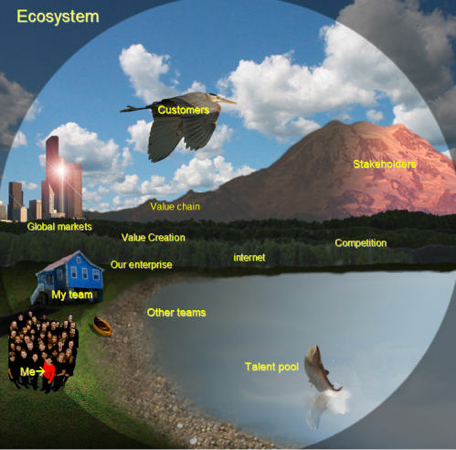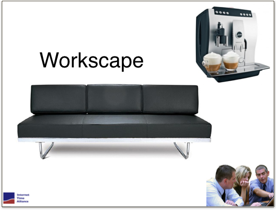Looking Through the Workscape Lens (2 of 2) – GUEST Post by Jay Cross
The previous post on this topic defined your Workscape as a systems view of where work is done and where people hone the skills they need to add value. It’s relationships and culture and secret sauce. It’s the organization as organism.
This post suggests how to nurture your Workscape — your Learning Ecosystem — to increase organizational performance. We’ll examine how Workscapes are changing, tools you can use to increase performance, an environmental impact report, and how to adopt a Workscape perspective on performance.
The Workscape is a systems-eye view of the workplace. Everything is connected. Rather than try to control nature, we do what it takes to keep the environment thriving.
Reading the temperature
The climate for Workscapes is changing, forcing a re-think of how things are connected.
- Decision-making is migrating from institution to individual, from training to pull learning, and shifts “power to the people.” This is how digital transformation works: digital democracy first. Digital citizens exploit connections and take power. Making the shift is an enormous change management task.
- Informal, experiential work is three times more effective than formal, top-down training. Experiential earning is migrating into the workflow at a very fast rate. Spread the footprint of the Workscape to the optimal size.
- Workscapes are complex and unpredictable, in perpetual beta. Experiments are cheap. Plant lots (hundreds, thousands) of Workscape experiments and nurture those that catch on. Watch out for monoculture (using only one solution) and the echo effect (making judgments from a narrow spectrum of reality).
- Nurturing the Workscape requires competencies such as business problem analysis, collaboration experts, community managers, and moxie. I foresee learning process SWAT teams attacking connection gaps. You don’t have these people on board now.
Forget about the traditional way you’ve trained people. Unlearn your assumptions about courses and top-down learning. Break with the present by looking ahead five years. Start with a blank piece of paper. Take a Workscape perspective. Assess the organizational benefits of:
- embedding learning in work, covering a much larger audience
- setting up learning as a continuous activity, not an event
- leveraging self-sustaining processes instead of one-time courses
- pinpointing high-return activities such as manager coaching
- embracing social and experiential learning
- changing the learning philosophy from push to pull
- employing business metrics to gauge success
- canvasing the organization for opportunities instead of waiting for requests
- focusing on overall business outcomes
- building self-sufficient teams
- extending the Workscape to cover partners, customers, and outsourced services
- making learning a driver with business impact
The Learning Conservationist Toolkit
L&D’s collaboration experts and SWAT teams are digital MacGyvers who weave techniques like these into Workscapes:
Make Management responsible for development
- Issue stretch assignments to grow staff
- Mentors, coaching
- Action learning
Personal Learning Network
- Collaboration and cooperation
- Friends and colleagues provide answers
- Peer learning
Performance support
- Job aids, bookmarks,
- FAQs, aggregation, curation
Access to information
- Wiki, inhouse YouTube, internet
- Self-study catalog, portals
Enterprise social network
- Activity stream keeps one up to date
- Platform for conversation
- Opportunity to share knowledge
Communities of Practice
- Professional growth
- Knowledge repository
- Create knowledge
Blogs
- Individual publishing (Learn out loud!)
- Follow thinking of others
Social learning
- Make conversation easy
- Collaboration
Mobile
- DIY
Performance feedback
- Is it working? How can we do better?
Microlearning
- Learning in tiny bites
Instead of taking requests, the traditional role of training departments, learning conservationists actively seek out opportunities where learning will have the most impact.
One group of L&D special agents posted this set of beliefs to explain how it worked to its internal clients:
- We are open and transparent.
- We narrate our work. Need to share.
- We support continuous learning, not events.
- We value conversation as a learning vehicle.
- We drink our own champagne (or mimosas).
- Business success is our bottom line.
- We are not a training organization.
- We value time for self-development and reflection.
- We establish business metrics for every engagement and report back publicly on outcomes.
Changing the physical environment can improve learning.
The staff will use any tool available to improve learning, right down to moving the furniture. A computer manufacturer discovered that its chip designers learned from overhearing conversations among their peers. They replaced a cube farm with comfortable sofas, rolling white boards, and espresso machines — and watched the production of innovative ideas skyrocket.
Environmental Impact Report
In a 2011 book, A New Culture of Learning, Douglas Thomas and John Seely Brown described the kind of learning necessary in this new environment as “whitewater learning”—the ability to acquire useful knowledge and skills while at the same time practicing them in an environment that is constantly evolving and presenting new challenges. They argue that our learning environments need to match the speed and degree of change happening in the world around us. (1)
The emancipation of both nature and the human imagination depends first on the capacity to ‘unsay’ the world and, second, on the ability to image it differently so that wonder might be brought into appearance. (2)
Over a hundred CLOs told us what they were currently doing was insufficient to prepare them to deal with the future needs of the business. Obviously it’s time to do something different.
One way to accelerate people’s development is to optimize learning by looking at the organization as an organic, unpredictable, complex system. It’s time to fix the big picture by working on the level of the Workscape.
References
1. Aspen Institute, The Learning Ecosystem
2. James Corner, “Ecology and Landscape as Agents of Creativity,” in Ecological design and planning, George F. Thompson and Frederick R. Steiner, editors, (New York: John Wiley, 1997), p.99. quoted in Design Education and Innovation Ecotones by Ann Pendleton-Julian








